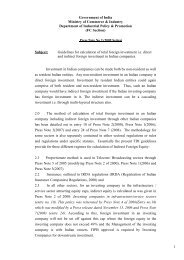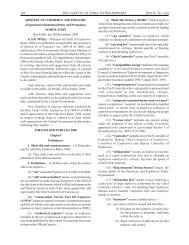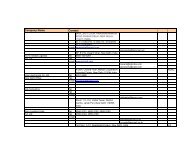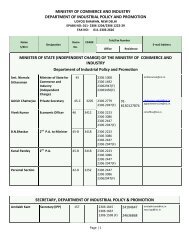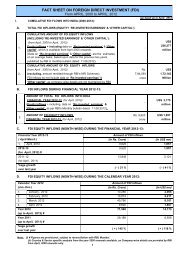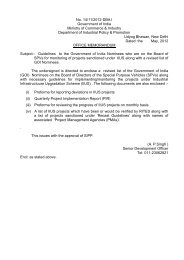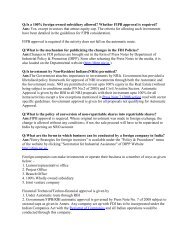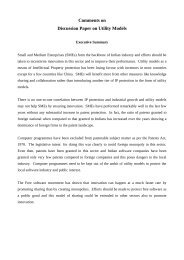GAS CYLINDERS RULES, 19811 - Department Of Industrial Policy ...
GAS CYLINDERS RULES, 19811 - Department Of Industrial Policy ...
GAS CYLINDERS RULES, 19811 - Department Of Industrial Policy ...
You also want an ePaper? Increase the reach of your titles
YUMPU automatically turns print PDFs into web optimized ePapers that Google loves.
CHAPTER IV<br />
EXAMINATION AND TESTING OF <strong>CYLINDERS</strong><br />
35. Periodicity of examination and testing of cylinders: — (1) No person shall fill any<br />
cylinder with any compressed gas unless the cylinder has been examined and subjected to<br />
hydrostatic test or hydrostatic stretch test, as the case may be, and other tests set forth in<br />
Schedule IV within such period as is specified in IS:8868 issued by Bureau of Indian<br />
Standards or as approved in writing by the Chief Controller.<br />
(2) Any testing station desiring to obtain recognition for periodical testing and<br />
examination of cylinders shall provide the facilities set forth in Schedule IV and<br />
shall submit to Chief Controller the particulars of the facilities provided and scrutiny<br />
fee specified in Schedule ‘V’<br />
36. Condemning of cylinders: — (1) Any cylinder which fails to pass periodic examination<br />
or test or which loses in its tare weight by over 5 per cent or which for any other defect is<br />
found to be unsafe for use or after expiry of the service life of the cylinder, shall not be<br />
filled with any compressed gas and shall be destroyed by flattening it as a whole or after<br />
being cut into pieces in such a manner that the pieces cannot again be joined together by<br />
welding or otherwise to form a cylinder, under intimation to the owner of the cylinder, as<br />
specified in IS:8198.<br />
Explanation: Service life of On-board CNG cylinders to be twenty years and Auto LPG<br />
containers made of low carbon steel to be fifteen years unless otherwise specified in the<br />
respective codes.<br />
(2) All markings on the cylinder shall be defaced before it is destroyed.<br />
(3) History sheets or records of such cylinders shall be closed and kept on record for a<br />
period of one year. Reports of the details of such closed history cards or records<br />
shall be sent to the Chief Controller, in writing, on the 1 st of January, April, July and<br />
October every year.<br />
(4) A cylinder, which has been used for the generation of any gas or for any purpose<br />
other than storage, transportation and use of compressed gas shall be deemed to have<br />
been condemned and unsuitable for such use as a cylinder within the meaning of<br />
these rules.<br />
CHAPTER V<br />
DISSOLVED ACETYLENE <strong>GAS</strong> <strong>CYLINDERS</strong><br />
37. Additional requirements for dissolved acetylene gas cylinders— Dissolved acetylene<br />
gas cylinder shall comply with following additional provisions, namely:-<br />
(i) The porous substance shall fill as completely as possible the cylinder into which<br />
the acetylene is compressed.<br />
(ii) The porosity of the substance shall not exceed 92 per cent and in no case shall be<br />
less than 75 per cent.<br />
(iii) Any solvent used shall not be capable of chemical reaction with the acetylene gas<br />
or with the porous substance or with the metal of the cylinder.<br />
(iv) If acetone is used as a solvent it shall comply with the requirements of IS:170,<br />
the quantity of acetone including the gas in solution shall be such that the<br />
cylinder meets the requirements of additional tests specified in IS:7312.<br />
(v) The valves of the cylinders shall not contain more than 70 per cent copper in<br />
their composition.<br />
(vi) The pressure in the cylinder shall not exceed 16 kgf/cm 2 at a temperature of<br />
15 0 C.<br />
(vii) Every cylinder shall before being filled with porous mass be tested by hydrostatic<br />
pressure to a pressure of not less than 60 kgf/cm 2 . This pressure may be reduced<br />
to 53 kgf/cm 2 if the cylinder is fitted with fusible plug. No cylinder which shows<br />
a permanent stretch in excess of 7½ per cent of the total stretch suffered during<br />
hydrostatic stretch test shall be allowed.<br />
14



